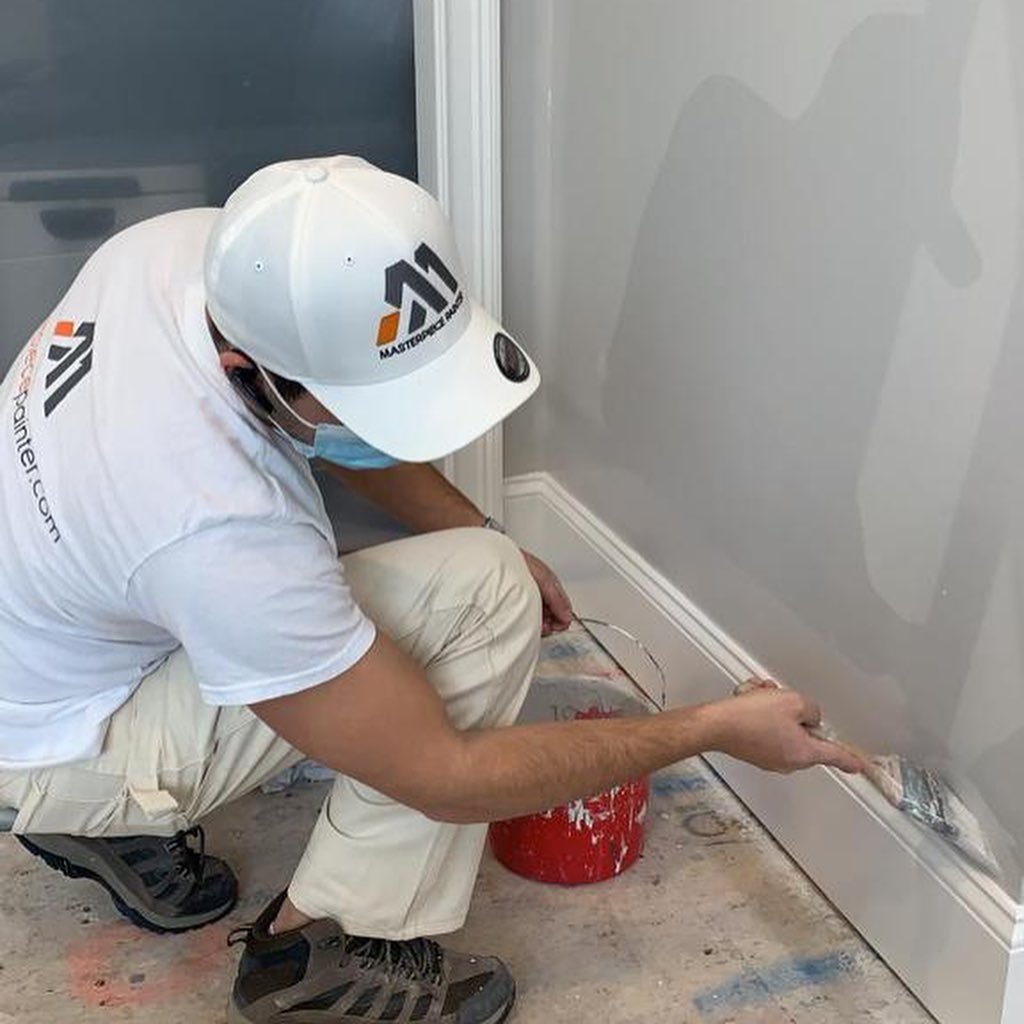Blogs

How to Paint Baseboards with Carpet | No Mess Tips
Painting baseboards in a room with carpet can seem daunting due to the risk of getting paint on the carpet fibers. However, with the right tools, meticulous preparation, and a careful application process, you can achieve clean, crisp lines without a single drop of paint ending up where it doesn't belong. This guide will walk you through the steps to successfully paint your baseboards while protecting your carpet.
Tools you’ll need
Having the right tools on hand will make the job much easier and ensure a professional finish.
Paintbrush: A high-quality angled sash brush (1.5 to 2.5 inches wide) with synthetic bristles is ideal for cutting in precise lines and getting into the curves of baseboard profiles.
Paint: A durable, semi-gloss or satin finish interior trim paint (100% acrylic latex enamel is highly recommended for its durability and easy cleanup).
Primer: A good quality interior primer, especially if you're painting new, bare, or previously stained baseboards.
Painter's Tape: High-quality painter's tape, such as FrogTape or 3M Scotch Blue, to create crisp lines along the wall. Some professionals also recommend a stronger masking tape (like packing tape) for tucking under the carpet.
Putty Knife or Drywall Knife: Essential for tucking tape under the baseboard and for creating a clean edge against the carpet. A 4-inch to 12-inch drywall knife can work well.
Drop Cloths: Plastic or canvas drop cloths to protect the main carpeted areas from drips and splatters.
Cleaning Supplies: Damp cloths, mild detergent, or specialized household cleaner for wiping down baseboards.
Sanding Sponge or Fine-Grit Sandpaper: (180-220 grit) for smoothing out imperfections and scuffing the surface.
Wood Filler/Spackle: For repairing nail holes and minor imperfections.
Caulk and Caulk Gun: For sealing gaps between the baseboard and the wall.
Optional: A paint tray, a small paint pail, or a metal sheet/paint shield to guide your brush.
Prepping the area without removing carpet
Thorough preparation is the most critical step to avoid getting paint on your carpet. Do not skip or rush this phase.
Clear the Area: Remove all furniture, décor, and anything else that might obstruct your access to the baseboards. Vacuum the carpet thoroughly along the baseboards to remove dust, lint, and pet hair.
Clean the Baseboards: Wipe down the baseboards with a damp cloth to remove any dust, dirt, or grime. For heavily soiled areas, use a mild detergent or an all-purpose cleaner. Allow the baseboards to dry completely before proceeding.
Inspect and Repair: Examine the baseboards for any nail holes, cracks, or dents. Fill these imperfections with wood filler or spackle, ensuring it's an interior-grade, paintable product. Once dry, lightly sand the repaired areas smooth and wipe away any dust.
Caulk Gaps: Apply a bead of paintable caulk along the top edge where the baseboard meets the wall. This fills any gaps and creates a seamless transition. Smooth the caulk line with a wet finger or a caulking tool. Allow the caulk to cure completely as per manufacturer instructions.
Sand Lightly: If your baseboards are new, previously painted with a glossy finish, or have areas that were repaired, lightly sand them with a fine-grit sanding sponge (180-220 grit). This provides a "tooth" for the new paint to adhere to. Wipe away all sanding dust with a damp cloth.
Protect the Carpet:
Tuck Tape Under: This is the most effective method. Take strips of high-quality painter's tape (or even a stickier masking tape) and, using a putty knife or a drywall knife, carefully tuck the tape under the very bottom edge of the baseboard, pushing it down between the baseboard and the carpet. The goal is to create a barrier that holds down the carpet fibers and provides a straight line for your brush. Ensure the sticky side of the tape is facing down onto the carpet.
Overlap with Drop Cloths: Once the tape is in place, lay down plastic or canvas drop cloths over the rest of the carpeted area, overlapping them with the tape. This protects the wider carpet area from drips and splatters.
Step-by-step painting process
With the area prepped, you're ready to paint. Remember that two thin coats are always better than one thick coat.
Prime (If Necessary): If your baseboards are bare wood, heavily stained, or you're making a significant color change, apply a thin, even coat of interior primer. Use your angled brush to carefully apply the primer, paying close attention to the bottom edge where it meets the tucked-in tape/carpet. Allow the primer to dry completely according to manufacturer instructions.
Mix Paint and Load Brush: Stir your paint thoroughly before pouring it into a paint tray or a small paint pail. Dip about one-third of your angled brush bristles into the paint, then tap off any excess on the side of the tray or can. You want enough paint for good coverage but not so much that it drips.
Paint the Top Edge (Cutting In): Start by "cutting in" the top edge of the baseboard where it meets the wall. Use the angled tip of your brush to create a straight, clean line. Work slowly and methodically, maintaining a steady hand. If you used painter's tape on the wall, paint carefully up to the tape's edge.
Paint the Body of the Baseboard: Once the top edge is cut in, paint the main flat surface of the baseboard. Use long, smooth, even strokes, working in sections. Apply gentle pressure to ensure paint gets into any profiles or details of the molding.
Paint the Bottom Edge (Carpet Line): This is the most critical part when working with carpet. Hold your brush at a 45-degree angle. Gently push the bristles into the very bottom edge of the baseboard, using the tucked-in tape or your putty knife as a guide/shield. Glide the brush along the tape, letting the tape catch any errant paint. If using a putty knife as a shield, move it along the baseboard as you paint, wiping it clean frequently.
Apply Second Coat: Allow the first coat of paint to dry completely (check manufacturer's recommendations, usually 2-4 hours). Then, apply a second thin, even coat following the same process. This ensures full coverage, optimal color, and maximum durability.
Tips to prevent paint on carpet
These techniques are your best defense against paint splatters and seep-through.
Master the "Tuck and Tape" Method: As detailed in preparation, this is your primary line of defense. Ensure the tape is firmly pressed down and tucked snugly under the baseboard.
Use a Drywall Knife as a Shield: For extra protection, especially if you're not confident in your brush skills, hold a wide (4-inch to 12-inch) drywall knife or paint shield directly against the baseboard and on top of the carpet as you paint the bottom edge. Glide it along as you go, wiping it clean frequently with a damp rag.
Don't Overload Your Brush: Excess paint on your brush is the primary cause of drips and splatters. Always tap off the excess.
Work Slowly and Methodically: Rushing leads to mistakes. Take your time, especially around the carpet line.
Keep a Damp Rag Handy: For immediate wipe-ups of any tiny drips or smudges on the carpet. Speed is key for fresh paint spots.
Consider a Specialty Edging Tool: Some tools are designed specifically to help create clean lines against carpet, acting as a guide for your brush.
Cleanup and final touches
The final steps ensure a clean, crisp finish and proper care for your tools.
Remove Tape While Paint is Wet (or Tacky): For the cleanest lines, carefully peel away the painter's tape (both from the wall and the carpet) when the paint is still slightly wet or tacky. If the paint is fully dry, it can bond to the tape and potentially peel off with it. If the paint is dry, use a sharp utility knife or a putty knife to lightly score along the edge of the tape before peeling to break the paint's seal.
Clean Up Any Bleed-Through: Despite your best efforts, sometimes a tiny bit of paint might seep under the tape. For latex paint, immediately wipe up any wet spots on the carpet with a damp cloth or baby wipe. For dried latex paint spots, specialized latex paint removers for carpet are available, or you can try gently scraping it off once dry. For oil-based paint, you'll need mineral spirits or a specific oil-based paint remover.
Inspect and Touch Up: Once all the tape is removed, step back and inspect your baseboards. Touch up any small areas that need it.
Clean Tools: Clean your brushes and paint trays immediately with soap and water (for latex paint) or mineral spirits (for oil-based paint). Properly cleaned tools will last longer.
Store Leftover Paint: Seal your paint can tightly and store it in a cool, dry place away from extreme temperatures to preserve it for future touch-ups.
By following these detailed steps, you can confidently paint your baseboards, achieving professional-looking results without fear of damaging your carpet.
About Masterpiece Painter
For over 17 years Masterpiece Painter, has been serving communities all around New England. Let us help you make your wishes come true by turning your property into a Masterpiece
Get a Quote

© copyright 2023 All Rights Reserved.



